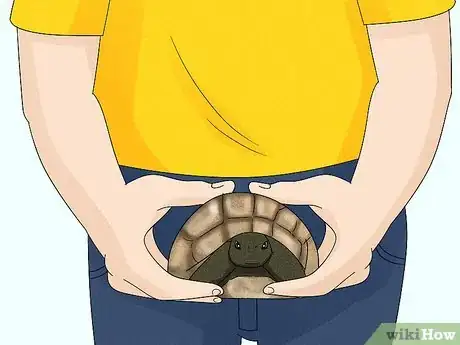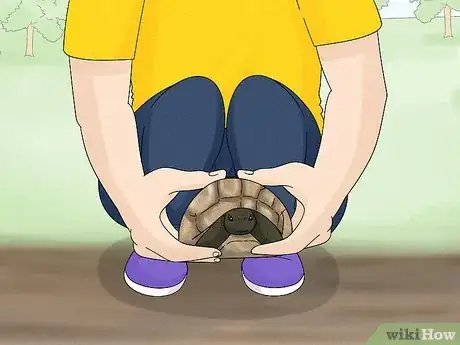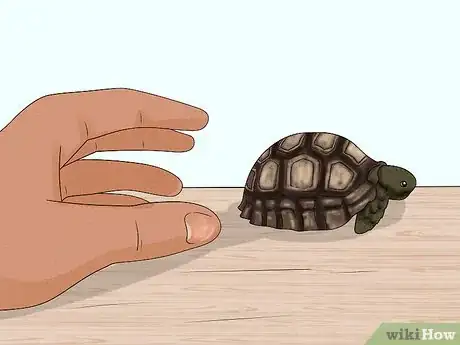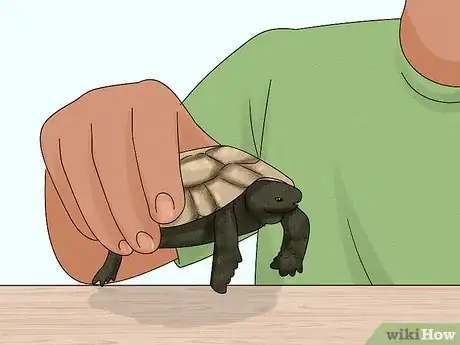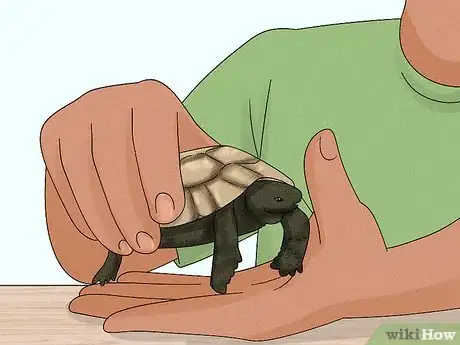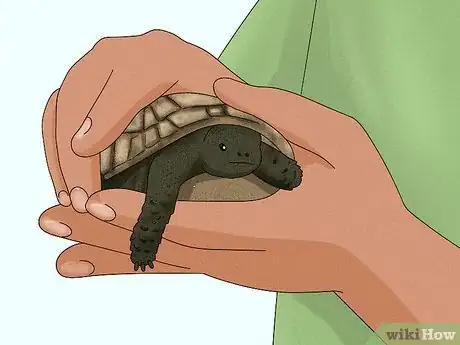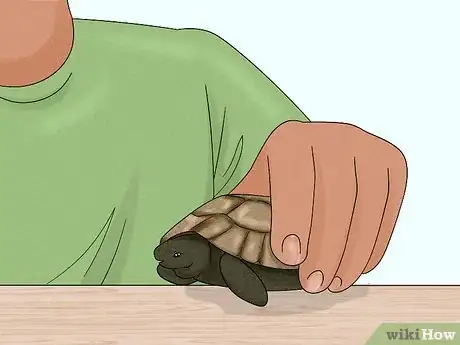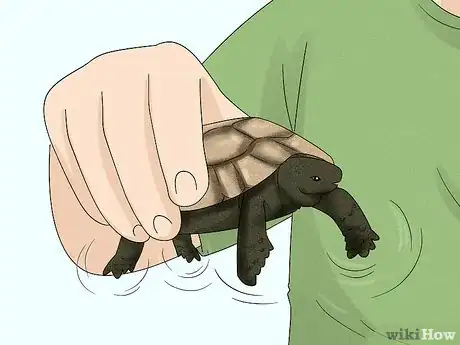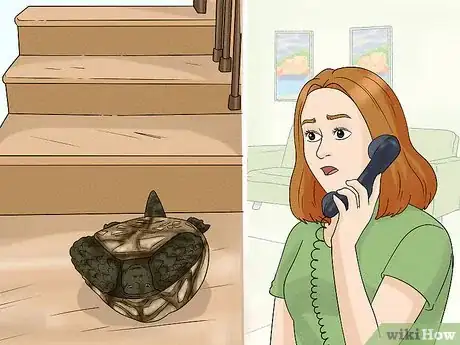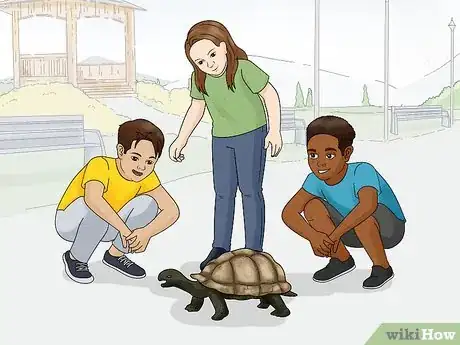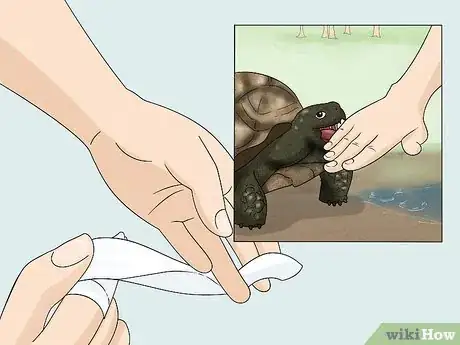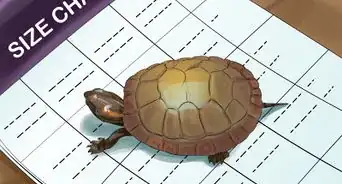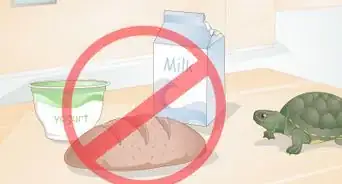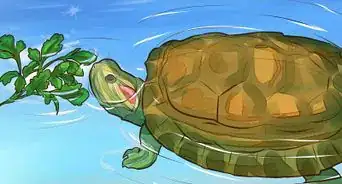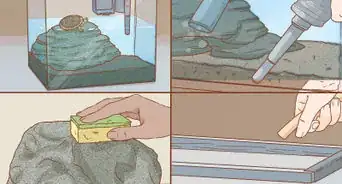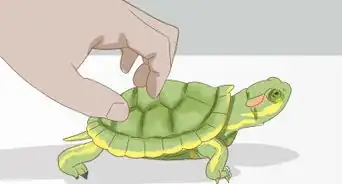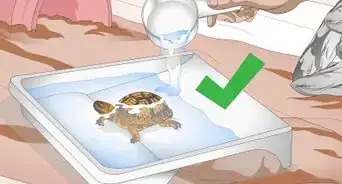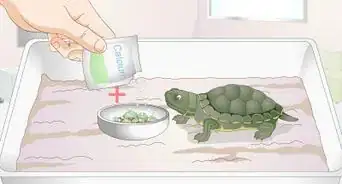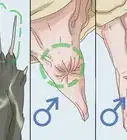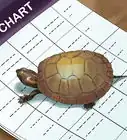This article was co-authored by wikiHow staff writer, Christopher M. Osborne, PhD. Christopher Osborne has been a wikiHow Content Creator since 2015. He is also a historian who holds a PhD from The University of Notre Dame and has taught at universities in and around Pittsburgh, PA. His scholarly publications and presentations focus on his research interests in early American history, but Chris also enjoys the challenges and rewards of writing wikiHow articles on a wide range of subjects.
This article has been viewed 12,550 times.
Learn more...
A tortoise, whether wild or a pet, baby or an adult, is a fascinating creature that you should enjoy observing rather than handling. If you do need to handle a tortoise, take a few sensible precautions to keep the animal calm and safe. Then you can get back to watching this cool creature!
Steps
Adult Tortoise
-
1Approach the tortoise slowly, calmly, and quietly. Whether they know you or not, tortoises startle easily. Being lifted up is always a stressful situation for a tortoise, so do your best to maintain a tranquil environment. For example, don’t surprise the tortoise by approaching it from behind—instead, approach it from the front, then move around behind it to pick it up.[1]
- If you startle or stress out a tortoise, it’s more likely to release its bladder and bowels all over you when you pick it up. Beyond the mess that tortoise pee and poop makes, this release can cause dangerous dehydration in wild tortoises in particular.
-
2Grasp it firmly with clean hands at the 3 and 9 o’clock positions. Clean your hands thoroughly before handling any tortoise, even if it’s your pet. Even better, put on disposable latex or non-latex gloves after washing up. Reach down from directly behind the tortoise and grab the shell at each side—at 3 o’clock and 9 o’clock if you picture the shell as a clock face. Wrap your fingers around the underside of the shell edge while keeping your thumbs on the topside.
- Tortoises can spread parasites, intestinal worms, and communicable illnesses that may affect you or any other tortoises you handle. Always clean your hands thoroughly before and after handling a tortoise, and in between handling multiple tortoises.
Advertisement -
3Lift it no higher than your waist, keeping it level with the ground. Never flip a tortoise over! A tortoise is helpless in this position and will become extremely stressed. Lift it straight up off the ground only as high as needed. Don’t lift it above your waist level unless absolutely necessary.
- This is the safest position for your hands and body, but don’t assume that you’re 100% safe! An agitated tortoise may be able to smack your hand or leg with one of its surprisingly powerful limbs. Some tortoises can even crane their necks far enough back to bite your hand in this position.
-
4Move it only as far as necessary, then put it down gently. The more you carry a tortoise, the more likely it is to fall. Injuries from falls are often fatal for tortoises, so it’s simply not worth the risk to lift one unnecessarily. Once you’ve lifted and moved the tortoise, lower it down slowly and calmly, reversing the lifting process.[2]
- The only legitimate reason to move a wild tortoise is if it’s in imminent danger—for instance, if it has wandered onto the road. In this case, carry it no more than 50 ft (15 m) in the direction it was already pointed and put it back down.
Baby Tortoise
-
1Remain calm and gentle as you handle the baby tortoise. Tortoises, whether young or old, scare easily—most especially if they’re picked up. They’re likely to treat loud noises and even gentle handling as a threat, not as playfulness or affection. So it’s important to keep your cool when you need to pick up a young tortoise.[3]
- If it’s a pet tortoise, go ahead and call it by name and speak to it calmly: “Okay, Bennie, now I’m going to pick you up just for a few seconds.”
- There’s no denying it—baby tortoises are super cute! Even so, resist the urge to pick one up just because you want to cuddle it. It’s safer and healthier if you simply enjoy watching the baby tortoise and only pick it up when necessary.
-
2Grasp the shell with a clean hand, fingers spread wide and even. Looking from above, imagine the baby tortoise’s shell is a clock face. Spread out your freshly-washed hand and place your fingers and thumb at roughly the 10 o’clock, 11 o’clock, 1 o’clock, 2 o’clock, and 7 o’clock positions. Press your fingertips very lightly against the edge of the shell. Get a secure grip but don’t squeeze the shell.[4]
- Wash your hands with soap and water or thoroughly clean them with hand sanitizer both before and after handling any baby tortoise. For added protection, put on a pair of disposable gloves. If you’re handling more than a single tortoise, wash your hands and change gloves in between.
- Baby tortoise shells are not as strong as adult shells. Be as gentle as possible while maintaining control.
-
3Slide your other clean hand underneath the tortoise before lifting it. While keeping hold of the shell with one hand, lift ever so slightly just so that you can slip your other hand, palm facing up, under the tortoise’s body. Let the baby’s weight rest on your palm, but keep a light grip on the shell with your other hand. Slowly lift the tortoise straight up, lifting it only as high and moving it only as far as is necessary.[5]
- Yes, the baby tortoise may pee or poop on your hand. Just wash up well afterward!
- Keep the tortoise upright—shell side up—at all times. Flip the tortoise over to look at its underside only in an emergency.
-
4Keep the baby tortoise supported and safe without squeezing it. A baby tortoise can get a bit squirmy, so make sure you keep hold of it. At the same time, though, it’s important not to squeeze too tightly. Make “gentle control” your goal! Also, like with adult tortoises, only hold a baby as high as necessary to reduce the danger of injury from a fall.
- If your pet baby tortoise ever falls more than a few inches/centimeters, or if you see any evidence of injury or shell damage, contact your vet. Contact a wildlife conservation officer if it’s a wild baby tortoise.
-
5Put the baby down with the same gentleness you used to pick it up. Slowly lower the tortoise straight down until the back of your hand touches the baby’s landing spot (the ground, its enclosure, etc.). Let go of the shell with your other hand and let the baby tortoise climb off of your flattened hand.[6]
- If the baby tortoise isn’t interested in walking off of your hand, gently grip the shell again, then lift ever so slightly just so that you can pull out your flattened hand from underneath. Let go with your other hand and allow the baby to go on its way.
Tortoise Safety
-
1Touch a wild tortoise only when its life is at risk. Many species of wild tortoise are critically endangered, and lifting or even touching one that you encounter will nearly always do more harm than good. Unless you’re a trained professional, you should only handle a wild tortoise if you are absolutely sure that it is at immediate risk of serious injury or death. Even then, handle it as little as possible.[7]
- If a tortoise is crossing a road with little to no traffic, for example, it’s best to leave it alone. If it’s a busy road, move it just to the other side of the road—no more than 50 ft (15 m) whenever possible—in the direction it was headed.
- If you suspect a problem that isn’t immediate, contact a wildlife commissioner, park ranger, conservation officer, or similar trained professional.
-
2Watch for signs of stress in your pet tortoise whenever you handle it. Generally speaking, less handling is better for all pet tortoises—they simply don’t require physical contact like pet dogs. While some tortoises may tolerate handling, most experience fear and anxiety when handled. Check for signs like the following that indicate your tortoise is experiencing major stress:[8]
- Emptying its bladder or bowels.
- Withdrawing completely into its shell.
- Kicking and scratching.
- Biting or attempting to bite.
-
3Call a veterinarian if the shell gets scratched or the tortoise falls. If a baby tortoise ever falls more than around 3–6 in (7.6–15.2 cm), or an adult more than around 6–12 in (15–30 cm), contact your vet, even if you don’t see any signs of injury. Any shell damage, no matter the cause, should also be immediately reported. Even a small shell scratch can develop a dangerous infection.
- Adult tortoise shells are tough, but they’re not impenetrable. Shells can be damaged, and any damage can be a serious problem.
- The undersides of tortoises are very vulnerable. Even a relatively short fall can prove fatal.
-
4Allow kids to observe, but not handle, tortoises of any age. Kids love to pick up animals like tortoises—and especially cute little baby tortoises. Unfortunately, kids are also more likely to drop a tortoise or squeeze it too hard. For the safety of all involved, it’s best to institute a “just look, don’t touch” policy.[9]
- Kids are also less likely to wash their hands well and keep them clean before and after handling a tortoise. This increases the likelihood of spreading illnesses from tortoise to child, child to tortoise, and tortoise to tortoise.
-
5Provide first aid treatment in the unlikely event of a tortoise bite. Tortoises generally don’t bite, but the stress of being handled may cause them to nip at you. While plant-eating tortoise species usually can’t do more than leave a bruise, some carnivorous species may be able to sever a finger with their bite. Take first aid measures based on the injury:[10]
- If the bite is painful but doesn’t break the skin, wash and dry the area, then apply an ice pack wrapped in a dishcloth.
- If the bite breaks the skin, wash the area with soap and water, apply pressure to stop the bleeding, apply an antibiotic ointment, and put on a bandage. Since tortoises can carry salmonella on their skin, it’s a good idea to contact your doctor for further guidance.
References
- ↑ https://irma.nps.gov/DataStore/DownloadFile/636808
- ↑ https://www.nps.gov/jotr/learn/nature/tortoise.htm
- ↑ https://irma.nps.gov/DataStore/DownloadFile/636808
- ↑ https://youtu.be/J4OLiHAgAuo?t=110
- ↑ https://youtu.be/J4OLiHAgAuo?t=110
- ↑ https://youtu.be/J4OLiHAgAuo?t=110
- ↑ https://www.nps.gov/jotr/learn/nature/tortoise.htm
- ↑ https://www.theveterinarynurse.com/review/article/stress-in-chelonians-tortoises-terrapins-and-turtles
- ↑ http://www.britishcheloniagroup.org.uk/caresheets/childtort?LMCL=VpYvjp


